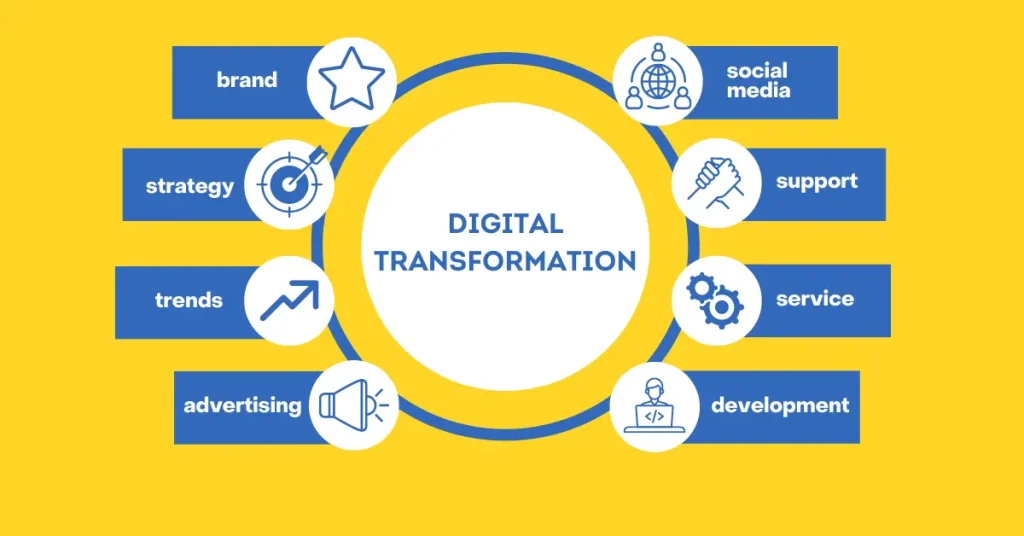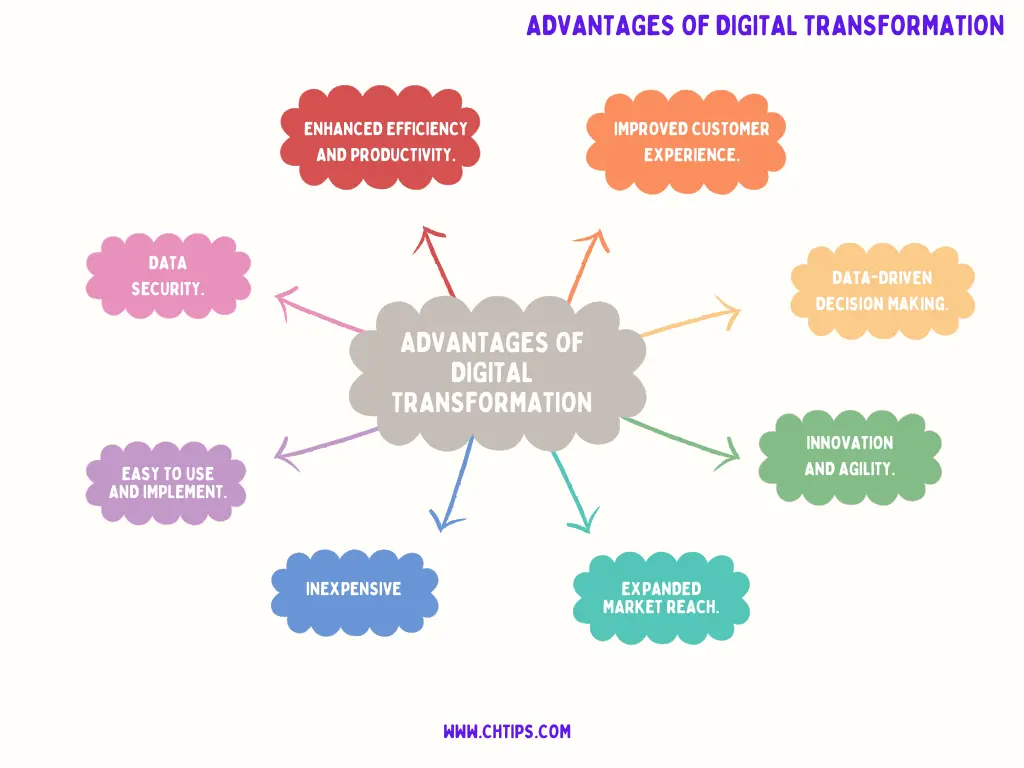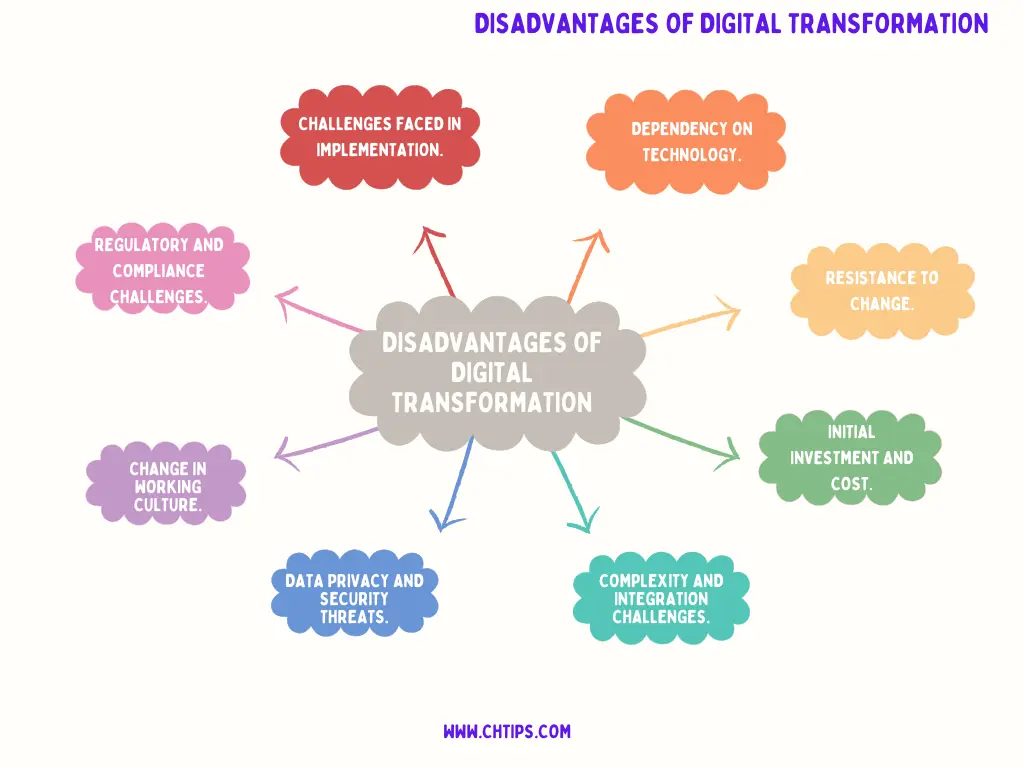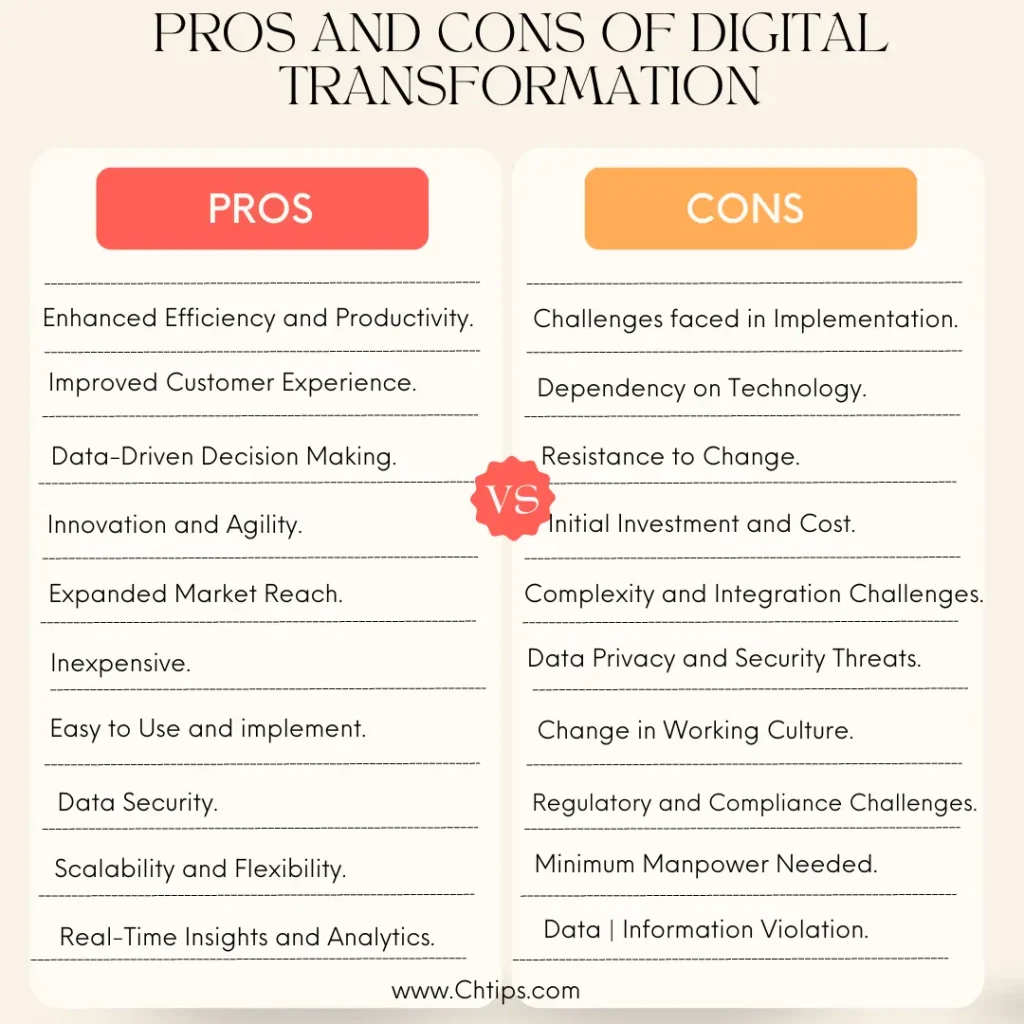Introduction to Digital Transformation and Workplace
Digital Transformation can be explained as introducing and utilizing new technology in business and organization. Digital transformation involves introducing tools, data security, automation, and data analytics.
Digital transformation has significantly improved efficiency, creditability, and reliability, which increased the overall performance of organizations and businesses.
Digital Transformation plays a vital role in data security, data breaches and avoiding and preventing cyber security issues.
The process and tasks can be automated, making seamless communication and collaboration with users and customers.
There are several significant Pros and Cons of Digital Transformation and Workplace with Advantages and Disadvantages of Digital Transformation, and hence it is primarily used in organizations.
What is Digital Transformation
While performing the digital transformation, a well-researched and strategic approach is needed. Digital transformation can automate tasks and operations with little human intervention and engagement.
The employees can access data and information anywhere in just a few clicks due to the centralized data centre.

Digital transformation benefits customers as they can easily communicate and interact with the business more efficiently than old-fashioned organizations.
In digital transformation, improved decision-making ability has increased considerably using current trends, data analytics, artificial intelligence and machine learning.
Digital transformation enhances and improve customer satisfaction with a user experience that allows more reviews and suggestion regarding product, sales, and services-related issues.
Advantages and Disadvantages of Digital Transformation | Pros and Cons of Digital Transformation
| # | Advantages of Digital Transformation | Disadvantages of Digital Transformation |
| 1 | Enhanced Efficiency and Productivity. | Challenges faced in Implementation. |
| 2 | Improved Customer Experience. | Dependency on Technology. |
| 3 | Data-Driven Decision Making. | Resistance to Change. |
| 4 | Innovation and Agility. | Initial Investment and Cost. |
| 5 | Expanded Market Reach. | Complexity and Integration Challenges. |
| 6 | Inexpensive. | Data Privacy and Security Threats. |
| 7 | Easy to Use and implement. | Change in Working Culture. |
| 8 | Data Security. | Regulatory and Compliance Challenges. |
| 9 | Scalability and Flexibility. | Minimum Manpower Needed. |
| 10 | Real-Time Insights and Analytics. | Data | Information Violation. |
10 Advantages of Digital Transformation in Points.

- Enhanced Efficiency and Productivity.
- Improved Customer Experience.
- Data-Driven Decision Making.
- Innovation and Agility.
- Expanded Market Reach.
- Inexpensive.
- Easy to Use and implement.
- Data Security.
- Scalability and Flexibility.
- Real-Time Insights and Analytics.
1. Enhanced Efficiency and Improved Productivity.
Completing tasks, operations, and instructions can be automated with just a few clicks using applications software specially designed and developed to achieve the desired results.
This process can significantly reduce the repetitions of work, with minimal errors | or inaccuracy. This eventually increases the overall performance efficiency and improves productivity.
2. Improved Customer Experience.
Digital transformation can primarily enhance the overall customer one on one experiences and customer satisfaction to the core.
The customer’s direct interaction with the business has contributed considerably to the relationship between the business and customers.
The various tools have offered users the chance to be a part of the change and also suggest some of their valuable suggestions and opinions regarding the betterment of the business.
These eventually helped organizations increase satisfaction, loyalty, and business growth.
3. Data-Driven Decision Making.
The business that uses and utilizes digital transformation can gather and store customer information and analyze and identify data for further handling and processing.
This valuable data and information gathered can be further used for strategic planning, decision-making, and business development.
Using Data-Driven Decision-Making, businesses can significantly improve operational costs, learn and analyze the latest market trends, and decide on data and information.
These techniques can enhance customer experiences compared to traditional methods of marketing.
4. Innovation and Agility.
Innovation and Agility Digital transformation is known to embrace innovation and adaptability inside an organization to advance in the technology and business sectors.
Innovations are necessary to change this new era for better performance and functionality significantly.
Innovation and agility can help in more creative thinking, using new trends or undergoing new experiments for fruitful results.
Technology innovation can kill competition in the respective business, giving it an edge over others.
5. Expanded Market Reach.
Expanded Market Reach can assist businesses in reaching new target audiences with broader and global reach. The targeted customer can be reached using just a few clicks using digital marketing, such as a Facebook ad campaign.
These users can be tapped using online and digital platforms for business development.
Using digital marketing, businesses can get reach beyond geographical boundaries. In Digital Transformation, businesses can acquire new customer segments and explore global markets.
6. Inexpensive.
Digital technology and digital transformation can make the operation of business inexpensive compared to old traditional style of working.
The digital transformation promoted automation in organization that can significantly reduce cost.
The paper usage can be restricted with huge savings on customer support and maintenance.
7. Easy to Use and implement.
Digital transformation is beneficial in business, as the strategies implemented in this technology are simple to use and execute.
Digital technology is user-friendly and simple to integrate with other businesses that enhances the organization’s overall performance.
There are several benefits of using digital transformation, such as efficiency, reliability, and powerful strategies to improve business.
8. Data Security.
Digital Transformation practices an additional layer of data and information security. It also secures data from unauthorized access with encryption methods.
It also prevents data loss, theft, and data violation.
9. Scalability and Flexibility.
Digital Technology can be scalable and highly flexible. This technology can cope with infrastructure changes and the need to expand the business locally and globally.
This technology can handle vast volumes of data to improve business productivity.
10. Real-Time Insights and Analytics.
Digital Transformation is capable of gathering extensive and essential information about the customers with customer insights and personalization.
This information is used to promote business, products, and services.
The information captured from customers can be further analyzed and diagnosed in real-time, which helps in decision-making.
Artificial Intelligence and Machine learning with computer vision are used to enhance business.
10 Disadvantages of Digital Transformation in Points.

- Challenges faced in Implementation.
- Dependency on Technology.
- Resistance to Change.
- Initial Investment and Cost.
- Complexity and Integration Challenges.
- Data Privacy and Security Threats.
- Change in Working Culture.
- Regulatory and Compliance Challenges.
- Minimum Manpower Needed.
- Data | Information Violation.
1. Challenges Faced in Implementation.
Digital transformation is a complex technology and challenging to implement and use. Digital technology needs some significant changes in technology infrastructure.
Sometimes the Implementation of digital transformation can be challenging.
Digital transformation needs special skills and knowledge to execute this technology to advance and improve the business.
Data and information security must be taken as additional concerns to avoid convenience.
2. Dependency on Technology.
Digital technology has remarkably changed organizations’ business processes and outcomes. The new advanced changes in the business style have increased without a considerable investment.
Due to advancements in business, modern business is totally and prominently dependent on digital transformation.
3. Resistance to Change.
Digital transformation brings a new working style and working culture to the organization. The roles, powers, and restrictions change significantly when this technology is used and utilized.
Employees working in traditional ways can find it difficult to merge with this digital transformation and adopt the new changes.
Sometimes employees can resist the changes. Therefore, the organization must slowly and gradually shift to digital transformation so that the employees can get familiar with the changes.
4. Initial Investment and Cost.
The initial investment and cost of implementing digital transformation can require a lot of investment in infrastructure changes, software licenses, and training.
The expenses of acquiring new technology, security measures, and data storage can lead to initial investment and cost.
5. Complexity and Integration Challenges.
Digital transformation can integrate new technology with enhanced software to derive accepted results.
This integration can be complex and time-consuming.
6. Data Privacy and Security Threats.
There are several securities with digital transformation and digital marketing, such as data and information violations, cyber threats, security breaches, and privacy concerns.
Sensitive and personal information can be compromised if not tackled with uttermost priority. Data and information theft or misuse can damage the reputation of any organization.
7. Change in Working Culture.
The working culture has dramatically changed with the introduction of digital transformation in any business and organization.
The use and utilization of digital technology have significantly and incredibly impacted business and style |working principles.
Digital transformation has changed business communication and collaboration with users and customers.
This working culture is easier to adopt if the employees are familiar with and habituated to old traditional ways.
8. Regulatory and Compliance Challenges.
There are specific regulatory and compliance challenges regarding their business and organization. Data and information protection and complying with evolving regulations require ongoing monitoring and adaptation.
9. Minimum Manpower Needed.
Digital transformation needs fewer human resources, which could impact unemployment. Digital marketing and transformation are automated using specific tools and applications.
Digital transformation uses the latest and enhanced technology like machine learning[MI], computer vision and artificial intelligence[AI] for better usability, performance and functionality.
This latest technology needs less human intervention to handle the tasks and operations with intelligent solutions to the problem.
10. Data | Information Violation.
The data and information can be handled and used while performing digital transformation and digital workspace.
Advantages and Disadvantages of Digital Transformation PDF Download
Advantages and Disadvantages of Digital Transformation | Pros and Cons of Digital Transformation Using Infographics

Recommended Reading
- Which Statement Describes A Characteristic of Cloud Computing
- What is Integrated Document Management System | 4 Types, Components
- Which Factors Have Made Edge Computing Cheaper and Easier?
- How Does Edge Computing Reduce Latency For End Users
- How Can Edge Computing be Used to Improve Sustainability 5 Reasons
- 6+ Different Types of Records Management Software
- Computer Basic Tutorials
What are the 4 key Challenges of Digital Transformation?
- Cultural Resistance.
- Legacy Systems and Infrastructure.
- Data Management and Privacy.
- Talent and Skill Gap
4 Characteristics of Digital Transformation?
- Technology Integration.
- Customer-Centricity.
- Agility and Adaptability.
- Data-Driven Decision Making
What are the 3 Main Components of Digital Transformation?
Components of Digital Transformation
- Optimizing processes.
- Focus on the customer experience (CX)
- Empowering employees.
6 Dimensions of Digital Transformation?
Here are six dimensions of digital transformation.
- Strategy and Leadership.
- Customer Experience.
- Operations and Processes.
- Business Model Innovation.
- Technology and Infrastructure.
- Culture and Talent.
4 Domains of Digital Transformation?
Digital transformation can be categorized into different domains that are mentioned below.
- Customer Experience (CX) Transformation.
- Operational Transformation.
- Business Model Transformation.
- Cultural and Organizational Transformation.
4 Stages of Digital Transformation?
Understanding the 4 stages of digital transformation and what you need to move forward
- Planning.
- Implementation.
- Acceleration.
- Measurement.
Different Types of Digital Transformation
Digital transformation focuses on different forms such as focuses, goals, etc.
Below I have listed some of the different types of digital transformation.
- Customer User Experience.Operational Transformation.
- Product and Service Innovation.
- Business Model Transformation.
- Data and Analytics Transformation.
- Cultural and Organizational Transformation.
- Supply Chain and Logistics Transformation.
- Sustainability and Environmental Transformation.
Purposes of Digital Transformation
Here I have mentioned some of the objectives and purpose of the digital transformation.
- Enhancing operational efficiency.
- Improving customer experience.
- Fostering innovation and agility.
- Enabling data-driven decision-making.
- Expanding market reach and competitiveness.
- Empowering employees.
5 Examples of Digital Transformation in Workplace?
Examples of Digital Transformation in the Workspace are included.
- Adoption of Cloud Computing.
- Artificial Intelligence (AI) Integration.
- Automation Processes.
- Data Analytics and Reports.
- Customer Relationship Management (CRM) Systems.
Helpful Video: Benefits and Drawbacks of Digital Transformation
Pros and Cons of Digital Transformation in Workspace
There are several pros and cons of digital transformation in the workspace.
| # | Pros of Digital Transformation | Cons of Digital Transformation |
| 1 | Increased Efficiency. | Technological Challenges. |
| 2 | Enhanced Collaboration & Compatibility. | Security and Privacy Risks. |
| 3 | Improved Productivity and Performance. | Workforce Adaptation. |
| 4 | Enhanced Innovation and Creativity. | Digital Divide. |
| 5 | Enhanced Employee Experience | User Satisfaction. | Dependency on Technology. |
Frequently Asked Questions [FAQs] On Digital Transformation Advantages and Disadvantages
What are the 4 pillars of digital?
Uplift, digitizing operations, digital marketing, and digital businesses.
Who is the father of digital marketing?
Philip Kotler.
What are the 3 R’s of digital transformation?
1. Reimagine.
2. Roadmap.
3. Results.
Examples of digital systems?
Computers, smartphones, scanners, and laptops.
5 Digital technologies?
1. GPS
2. 5G and Virtual Reality.
3. Cloud and SaaS.
4. Artificial Intelligence (AI)
5. Bitcoin and blockchain.
Five pillars of digital transformation?
1. Vision.
2. Customer understanding.
3. Technology alignment.
4. Metrics and measurement.
5. Governance.
3 Benefits of digital transformation?
1. Increases Customer Satisfaction.
2. Drives Data-Based Insights.
3. Enables High-Quality User Experience.
Get in Touch
Some of the other significant benefits of digital transformations are included.
- Competitive Advantage.
- Improved Collaboration and Communication.
- Enhanced Supply Chain Management.
- New Business Models and Revenue Streams.
- Improved Compliance and Risk Management.
- Enhanced Supply Chain Management.
Some Drawbacks of digital transformation are mentioned below.
- Competitive Advantage.
- Improved Collaboration and Communication.
- Enhanced Supply Chain Management.
- New Business Models and Revenue Streams.
- Improved Compliance and Risk Management.
- Enhanced Supply Chain Management.
The use and utilization of digital transformation have drastically changed organizations’ overall working and business methods.
Digital transformation has enhanced and improved customer experience and collaboration and strengthened employees, eventually giving a competitive edge over others.
I have also written and compiled some articles on computers and telecommunications, and please go through them.
I hope you will like reading it.
All the questions and queries related to Pros and Cons of Digital Transformation and Workplace and Examples have been answered here.
If you have questions about the Advantages and Disadvantages of Digital Transformation and the Workplace.
Don’t hesitate to contact me, and if you need to add, remove, or update anything from the article, please let me know in the comment section or via email.
I will be more than happy to update the article. I am always ready to correct myself.
I would like you to share this article with your friends and colleagues; this motivates me to write more on related topics.
!!! Thank You !!!